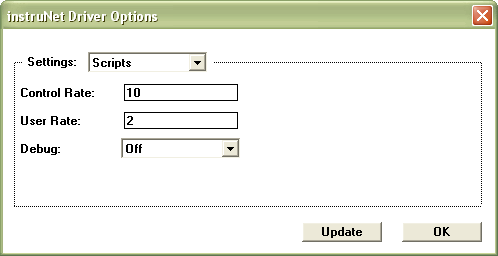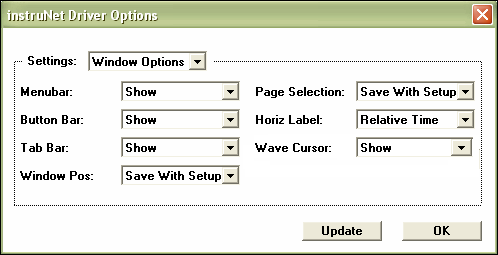SCRIPT REFERENCE Table Of Contents
The Script Page 
All script code is automatically saved inside a .prf instrument file when one presses the Network page Save button or selects Save Setup in the Setup menu. The Script page contains a text editor that supports typing, placing an insertion point, scrolling vertically, selecting text, cutting text to the clipboard, copying text to the clipboard, and pasting text from the clipboard. The text editor is used to create, edit, view, execute, and test instruNet Scripts. The currently viewed script is specified with popup menus at the top of the window (e.g. After Select Page Record script), as illustrated below. The Execute button runs the current script, the Stop button stops any currently executing script, the Save/Save As buttons save the current script to disk in a text file, the Open button loads a text file into the current script, the Clear button clears the current script, and the Print button prints the current script to a hardcopy printer. For a description of script types, click here. For a description of buttons and menu commands that aid in the programming process, click here. Script Options Dialog box
Window Options Dialog box
To open this dialog, select Window Options in the Setup menu. The menu bar at the top of the window and the tab bars at the bottom of the window are sometimes hidden to reduce the number of options available to the instrument operator. Alternatively, one can hide the Tab Bar at the bottom and the Button Bar at the top to create more space, and rely entirely on the Menu Bar. To show the menu bar after hiding it, one can press keys CONTROL SHIFT 'M'. If one saves the Page Selection with the .prf file, then the page that is selected (e.g. Record) when one saves the .prf file is automatically loaded when one opens that file. If one saves the Window Position with the .prf file, then the Window position and size is restored when one loads the .prf file. Horizontal Timescale - Time of Day or Absolute Time
The typical iW+ instrument includes many different independent scripts. For example, one line of script code in a channel's Control Calculate field defines an analog or digital output channel as a function of other channels or mathematical functions (i.e. waveform generation or feedback/control); or one line of script code in a channel's Panel Meter Calculate field mathematically calculates a numeric representation of that channel to be displayed in the main window. In addition to the Control and Panel Meter calculate fields, many scripts are accessed in the Script page, after being selected in the upper-popup menus within that page, illustrated below. For information on how one script can run another script click here. The different types of scripts are described below: Panel Meter Calculate Field Control Calculate Field
Related Topics: Control and Waveform Generation discussion, Working with instruNet Hardware discussion, Output Waveforms that are defined with Mathematical Equations example, Feedback/Control Loop example.
The Control Script (i.e. execute every x seconds while digitizing) One can drive an output channel with its Control Calculate field, or with a line of code in the Before/After Control Script. The advantage of the Control Script is one can calculate an output value with multiple lines of script code (e.g. via "if ... then ... else"). To view/adjust the Control Script, select the Script page (i.e. click Script tab), and then select After Control Event or Before Control Event in the upper popup menus. The Control Script is disabled from executing when the Script page is selected, so it will not run while you are typing in it. Related Topics: Control and Waveform Generation discussion, Working with instruNet Hardware discussion, Output Waveforms that are defined with Mathematical Equations example, Feedback/Control Loop example. The User Script (i.e. execute every y seconds at all times) The Test Script The Scan Script The Digitization Script The Load Settings Script The Script Engine Script The Exit Program Script The Select Page Script The Press Button Script
|


